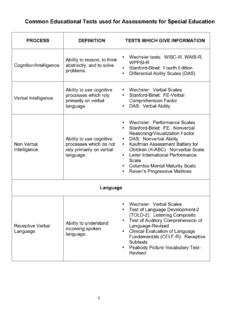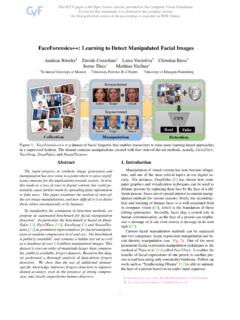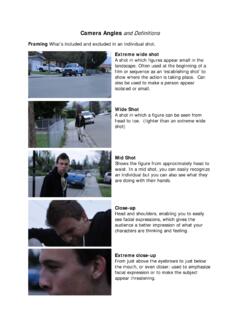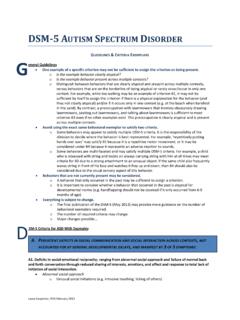Transcription of The Body Language
1 The body Language Dr. Haya Bint Ali Bin Hassan Al Noaimi Vice President of Community & Alumni Affairs University of Bahrain Career Counselling Office Career Guidance Division Phone: 17437442 17438054 Email: or What is body Language ? body Language is nonverbal communication that involves body movement . Gesturing can also be termed as body Language which is absolutely non-verbal means of communication. People in the workplace can convey a great deal of information without even speaking; through nonverbal communication. Not all of our values, beliefs, thoughts and intentions are communicated verbally. In an ongoing communication, most of those are communicated non-verbally. In Non-verbal communication, our human body expresses our feelings and intentions through conscious and unconscious movements and postures, accompanied by gestures, facial expressions, eye contacts and touch.
2 This collectively forms a separate Language of the body within the ongoing communication. This is called body Language . How Does the body Speaks? Our human body speaks through the conscious and unconscious movements and postures, hand gestures, facial expressions, eye movements and touch. Each of these physical movements of the body parts could be seen as separate words and can be interpreted differently by other human beings within a given context of communication. Why is body Language Important? Since interpretations of body Language differ from people to people and cultures to countries it is important to learn about them. body Language alone comprises of 55% of total communication whereas spoken words comprise of 7% and tone of voice comprise 38%. Types of body Language What types of body Language can be distinguished?
3 body Language is usually grouped along two 1. Parts of the body 2. Intent So what types can be found in each group? Parts of the body From head to toe, here are the groups when grouped for body parts: The Head - movement and placement of the head, back to front, left to right, side to side, including the shaking of hair. facial Expressions - The face has many muscles (anywhere between 54 and 98, depending on who you ask) that move several areas of the face. Each combination of movements of the following face elements communicates a state of mind: Eyebrows - Up, down, frowning. Eyes - Left, right, up, down, blinking, eye dialiation. Nose - Wrinkle (at the top), flaring of the nostrills. Lips - Smiling, snarling, puckered, kissing, opened, closed, tight. Tongue - In, out, rolled, tip up or down, licking of lips. Jaw - Open, closed, clinched, lower jaw left or right.
4 body Posture - The way you place your body and arms and legs, in relation to each other, and in relation to other people: body proximity - How far or close to other people. Shoulder movements - Up, down, hanging, hunched. Arm placement - up, down, crossed, straight. Leg and feet placement - straight, crossed, weight placement, feet towards speaking partner or pointing elsewhere, dangling of shoes. Hand and finger gestures - How you hold and move your hands and fingures are particularly insightful in reading people. Handling and placement of objects (eg. pens, papers, etc). - The odd one technically not a body part, but objects do play a big role in reading body Language . Intent Another way to group types of body Language is along Intent: Voluntary/Intentional movements - Usually called "Gestures". These are movements you intended to make, like shaking a hand, giving the finger, blinking with one Involuntary movements - Usually called "tells", but "ticks" also fall into this category.
5 Any body movement you have no cotrol over falls in this category. While technically not a body movement , sweating also applies. So where is Tone of Voice? While usually seen as body Language , tone of voice and intonation are a separate group from body Language . For completeness sake, these are the groups that are found in tone of voice: Pitch of voice - high voice, low voice, intonation. Loudness - Everything from shouting to whispering. Breathing - Slow, fast breathing, shaky voice. It is an expressive movements of a part of a body especially hands or heads . It has vital effect or part in oral communication. Gesture of a person convey much more than what he speaks. The body Language of Gestures Examples of gesture: Waving of hand to indicate good bye or draw the attention of a person Examples of gesture: Shrugging of shoulders indicates indifference & unconcern Examples of gesture: Pointing index finger indicates allegation or charge Examples of gesture: Shaking Hands display the friendship Examples of gesture: Thumbs up sign indicates wishing Good Luck The body Language of Posture Means an attitude or position of body Each movement of body has expressive & defensive functions.
6 The way, in which we sit or stand, walk in walk out tells a lot about us. A good posture indicates confident attitude. The body Language of movement facial Expression All facial organs on human face indicates facially expressive message. These are hair, forehead, eyebrows, eyes, mouth, chin, nose, lips, ears, teethe, tongue etc. facial expressions comes naturally hence it is beyond the control of speaker. Examples of facial Expression A Smile expresses friendliness & affection Examples of facial Expression Raised eyebrows convey surprise Examples of facial Expression Furrowed forehead expresses worries & anxiety Examples of facial Expression Frown shows dislike or suspicion Dress & Appearance The kind of dress we use & the way in which we groom ourselves shows our status & attitude. We influenced how others look & clothes they wear Physical attractiveness plays an important role in our assessment of people.
7 Persons dress & physical appearance conveys great deal of information about him. Eye Contact Eye contact has very much in face-to-face communication. Absence of eye contact shows lack of interest & understanding. We look faster than listen or talk. Eyes are human windows except them there is no life. The speaker must look in to the eyes of the audience from right to left & left to right this will built up the confidence & eliminate the nervousness. It build the rapport between the speaker & the listener. Silence speech is silver but silence is golden . It establishes the relationship between the communicators. Moments of silence do not know how to continue Voice Modulation The speaker must use his voice effectively. Someone wants to become a effective speaker, a good is must. A good voice is natural gift.
8 One can take the training of phonetics to improve his own voice. More body Language Examples and Their Meaning Arms Crossed in front of the Chest This is one of the body Language examples that indicate that one is being defensive. The body Language meaning of crossed arms may also show disagreement with opinions and actions of other people with whom you are communicating. Biting of nails Nail biting demonstrates nervousness, stress, or insecurity. Many people bite nails without realizing they have the habit. Hand on cheek This body Language example indicates that one is lost in thought, maybe considering something. When your hand is on your cheek and your brows are furrowed you may be in deep concentration. Finger tapping or drumming This action demonstrates that one is growing tried or impatient while waiting. Touching the nose Touching or rubbing the nose signifies disbelief, rejection, or lying about something.
9 Prisk rubbing of the hands This may show that the hands are cold, which may mean that one is excited about something, or waiting eagerly. Placing Finger tips together This is called steepling, or placing fingertips together to demonstrate control or authority. Open palms, facing upward This gesture is a sign of honesty, submission, and innocence. This is how some people show submission and respect. Head in hands The body Language meaning of this gesture may be that of boredom, being upset, or being ashamed, so one does not want to show their face. Locking of ankles Whether you are sitting or standing, when your ankles are locked, you are communicating apprehension or nervousness. Stroking the chin or beard This communicates that one is In deep thought. This action is often done unintentionally when one is trying to come up with some decision.
10 Ear Pulling Pulling an ear lobe can mean one is trying to make a decision, but remains indecisive about something. Head nodding This gesture usually signifies agreement or bowing, s submissive gesture that shows one is going along with another person s opinions. Lint picking Picking of imaginary lint is another one of the body Language examples of displacement gestures, which one uses to show disapproval of the attitudes or opinions of other. This action makes one look away from the other person while doing some irrelevant action. Catapult posture This seated version of the Hand-on-Hip male poster with the hands behind the head and elbows pointed out is used to intimidate or show a relaxed attitude. Thus giving a false sense of security before an ambush is made. Lowered head This indicates one is hiding something.










